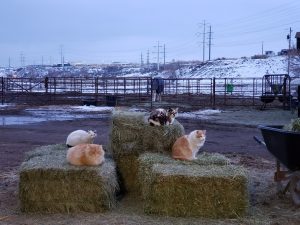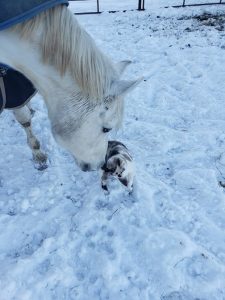“The greatness of a nation and its moral progress can be judged by the way its animals are treated.”
–Mahatma Gandhi
Last week marked one year since we released our once feral cats from the cattery at the barn. Trapped at the old slaughterhouse in Salt Lake City, these ferals were rehomed for their safety to the barn where I keep my horse. For over five weeks they had stayed in the largish enclosure inside the barn’s hay room slowly acclimatizing to their new surroundings, the smell of the horses, and to all of us curious onlookers who would come to check in on them when we were at the barn to see our horses. One of the cats, Inky, was bold, while the others mostly scattered into their straw-lined shelters at any sight of humans. Macita, the lovely girl with beautiful blue eyes was especially skittish, barely peeking out from her hiding spot, while Cheeto ensured we knew his displeasure, hissing at us every time he saw us.

The past year has offered fascinating opportunities to observe the development of our rambunctious, wild, and frankly distrusting ferals into sweet barn cats with stories that could match the sentimental nature of the childhood favorite, Charlotte’s Web. And just as we learn about the importance of relationships and community from Wilbur, Charlotte and the other cast of characters, watching the personalities of each of our feline friends emerge and seeing them learn to embrace other new four-legged characters into their community’s story have provided thought-provoking insights into what it means to foster belonging.
What Does It Take To Build Trust?
The transformation from feral to chatty, purring, barn cats has by no means been quick. It started with canned food served each night at dinner allowing us check them out daily and spot any health issues we could creatively address without the trauma of vet visits. Then they started greeting a few of us at our cars to shepherd us to the barn to feed them (yes, herding cats is real!). And over time, we have gone from being unable to touch most of them to being begged for cuddles from the Kuddle Krew. The very cats who were initially the most anxious about us are the ones who have undergone the most dramatic transformations. For Macita, it took moving the food dish to her every time another cat would push her off, sometimes six or seven times a meal, for her to see we were her ally. In September, she finally let just a couple of us touch her and more recently she has let more people inside her walls. Having grown in confidence she has even learned to snuggle with some of the horses as they put their heads over their gates. And Cheeto’s hisses have been replaced by constant purrs and demands for belly rubs as he throws himself onto his back at our feet. Each one of them has had their own path to letting their proverbial walls fall one human at a time. While others are still very early in their process of letting us touch them, they have learned to use their words especially when dinner is not being prepped fast enough. The reality is that we need to honor where they are in the process and meet them on their terms.
Grayson’s Quest for Belonging
Last summer, a bombastic grey tabby showed up one night at dinner. An intact male, Grayson was constantly picking fights and causing problems. The longer he was a regular at dinner the more it became clear he was feral with no human family of his own. It also was clear he needed to be fixed. More than six months after we trapped and fixed him, Grayson began his own transformation from loner to member of the community. It started by joining the others to greet me at my car a few months ago and spending more time at the barn during the day. He now follows the other cats, mimicking their social behaviors as they interact with us. And as he sits there with them, even if on the edge of the group, you can see him observing what they are doing and trying so hard to figure out how to fit in. Little by little, we see Grayson trying to hang out and eat with the other cats who are in turn learning to trust him more, albeit with the occasional setbacks. But perhaps the most welcoming has been Cheeto, who has made sure to show his vulnerability near Grayson, letting him see that we humans are kind to our kitties. And just as I did with Macita, I make sure to give Grayson my attention at dinner. He is growing to trust us and is feeling day by day more like this is his feline family.

Why Labels are a Helpful Step for Developing Belonging
But what do barn cats have to do with belonging? Despite a lifetime of experience with cats, working with these ferals has been a new experience. Many people have come into the barn thinking they can approach the cats just like other domesticated cats, but it doesn’t work that way. Knowing whether a cat is a house cat, feral or a barn cat provides insight into how to approach them. Those labels matter. I cannot treat all cats the same, just as assuming all humans are the same creates problems. We need to earn their trust and that looks different based on their background. Indeed, the label of “feral” and “barn cat” helped me know how to proceed with caution so as to help patiently establish a relationship. And as walls are dropped, and trust is built, relationships and a sense of belonging can develop.

We humans are fundamentally no different than these sweet creatures. Some people drive by us too fast without a care if they hurt us. Others may ignore us and not feel it is their responsibility to worry about whether or not we feel we belong and have our needs met. And yet fortunately others have the curiosity to understand what our individual needs are to help us move from the margins into the larger community thereby finding belonging.
Just as cats are not all the same, neither are humans. While we are all children of God, we do not all share the same life experiences. Being unmarried and alone in a family-oriented church culture can feel alienating. So can being from a different culture, race, range of abilities (think health), political leaning, etc. While we are all children of God, some people are Graysons, living on the margins wanting to be a part of our community, but struggling to do so. Some are repelled because they are different, while others find acceptance more easily. When we recognize and embrace the unique differences in our experiences, allow for those differences instead of ignoring them, we actually validate others thereby allowing walls to fall and bridges to be built.

Similarities, Differences, and Bridge Building
A former student of mine, Grant Jackson (now on faculty at Texas Tech), recently spoke to faculty about a bridge building program pioneered at Michigan. During the first week, group members worked on identifying the things they shared in common. While many people think this is all we need, the program did not stop there. The second week encouraged them to identify and share their diverse experiences and backgrounds. These different lived experiences allowed them to come together in week three to identify ways to build bridges. Without understanding our differences and our diverse experiences and reactions, we cannot build communities that build up their members and provide true belonging for all. Not just some, but all.
Our baptismal covenant teaches us that we must mourn with those who mourn and we must bear one another’s burdens. Brene Brown has noted that empathy does not stem from having firsthand experience with something but is instead borne of a willingness to sit in the darkness with someone. That darkness can be grief or pain. And a podcast that was recently shared with me noted that the first step to healing is to have our experiences validated by another person. In other words, having our experiences and differences validated enables us to access the atonement and find belonging with others.

We do not have to wait to meet others who are different, to increase our capacity to exercise empathy. It starts by reading about diverse experiences of individuals in literature. It starts by seeing the divinity in all of God’s creations, including especially the ones whose lives are unlike our own.
At this Easter season, we have the opportunity to see belonging in a new light: to meet people where they are and embrace their differences. To seek to understand what their needs are and what their stories are instead of expecting them to change simply because those differences are inconvenient to us. When we are willing to do that, we will be able to help others find increased belonging. And when they do at last experience belonging, then their true selves can emerge just as we’ve watched happen with our sweet Macita, Cheeto, Sam, and Cookie, and is now happening with Grayson. That is the power of belonging. And this is what a humanities education enables us to do.
This blog post was written by Laura Catharine Smith, an Associate Professor of German and Russian at BYU. Her friends call her a cat-whisperer.






